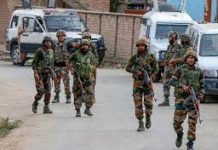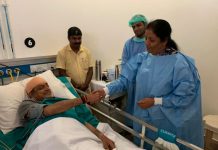
Kashi, which is in the eye of storm over Gyanvapi mosque row, has had a distinguished legacy where Hindus and Muslims have prayed close to each other in a temple and a mosque integrated with each other for the centuries. A report by Mudit Mathur
Is Kashi going to be next Ayodhya? After demolition of Babri mosque in1992 and all the accused persons including conniving official machinery honourably acquitted, the much-professed unfinished mission of Kashi and Mathura appears to be gaining momentum. The way Kashi controversy over a historical wrong is getting boiled up aggressively with incitement of religious passions, no one can deny that just a spark could repeat another Ayodhya in Kashi. Kashi – believed to be the world’s most ancient calm living city – turned into a supreme power centre after Prime Minister Narendra Modi won twice from this parliamentary constituency – had a distinguished legacy where Hindus and Muslims have prayed close to each other in a temple and a mosque integrated with each other for the centuries much before our Independence.
The most sacred religious place – Kashi, once known for peace and harmony is just sitting on a powder keg of communal divide where a spark is enough to trigger unimaginable riots and violence. Though the history is a non-justiciable subject in the jurisprudence, but spurt of fresh litigations have suddenly swelled the courts demanding to correct the historical wrongs by allowing their religious rights to worship inside controversial sites – those invaded by Mughal rulers destroying temples and converting them into mosques.
The Supreme Court bench comprising Justices DY Chandrachud, Surya Kant and PS Naramsimha,while ordering maintaining status quo clarified that the order passed by the Civil Judge Senior Division at Varanasi to protect the spot where a “shivling” was claimed to have been found during the survey of the Gyanvapi mosque will not restrict the right of Muslims to access the mosque to offer namaz and to perform religious observances (wuzu).
The apex court remanded the suit filed by Hindu devotees in connection with the Gyanvapi Mosque – Kashi Vishwanath Temple dispute to District Judge transferring it from the Court of Civil Judge Senior Division who passed controversial orders without disposing objections with regard to maintainability of the suit raised by Muslims. The suit was filed before the Civil Judge Senior Division, alleging that the Mosque was built after a Lord Vishweshwar’s temple was destroyed by Mughal emperor Aurangzeb.
The Supreme Court also ordered that the application filed by the Committee of Management of Anjuman Intezamia Masjid (which manages Gyanvapi mosque in Varanasi) before the trial court under Order VII Rule 11 CPC for rejection of the suit as being barred in law, shall be decided on priority by the District Judge. Meanwhile, its interim order dated May 17 shall continue in operation till the application is decided and for a period of 8 weeks thereafter. Further, the concerned District Magistrate has been directed to make proper arrangements for observance of wuzu.
One Rakhi Singh and the four other women had filed a suit before Civil Judge Senior Division in the Varanasi court seeking permission for regular prayers in the temple located inside the Gyanwapi mosque and contended that there are idols of Lord Ganesha, Hanuman and Nandi on the wall, which should be restored. Entertaining the plea, the court had appointed an advocate commissioner and asked him to video-graph the premises and submit a report. When the advocate commissioner was filming the interiors of the premises, the management of the mosque had objected to the exercise.
The counsel of the mosque management committee, Abhaynath Yadav, requested the court to replace the advocate commissioner, who was allegedly acting in a partisan manner. Yadav claimed that the court did not order any videography inside the mosque but the advocate commissioner was insisted on it. “As per the court order, the videography is to be done of the platform (Chabutra) called Shringar Gauri inside the mosque complex,” he added.
In compliance with the apex court orders, the District and Sessions Judge Dr Ajay Kumar Vishwesha has ordered first to hear the submissions of Anjuman Islamia committeeon on 26th May, 2022 with regard to question of maintainability of the suit under Order VII Rule 11 in view of objections raised at the beginning as preliminary objections. The Court has also invited objections from both parties to the Commission Report. The objections have to be filed within 7 days. The second part of the order could again open up a Pandora Box of conflicts.
The Uttar Pradesh is just witnessing spurt of communal tides over pre-independence contentious conflicts by right-wing hardcore Hindutva forces despite existence of the Places of Worship (Special Provisions) Act, 1991, whereby it was declared that the religious character of a place of worship existing on the 15th day of August, 1947 shall continue to be the same as it existed on that day.
It was further provided in Section 4 (2) of the Act 1991, that any suit, appeal or other proceeding with respect to the conversion of the religious character of any place of worship, existing on the 15th day of August, 1947, is pending before any court, tribunal or other authority, the same shall abate, and no suit, appeal or other proceeding with respect to any such matter shall lie on or after such commencement in any court, tribunal or other authority.
Analysing the 1991 Act, the Constitution Bench of the Supreme Court in its Ayodhya Verdict had held that, “The Places of Worship Act is intrinsically related to the obligations of a secular state. It reflects the commitment of India to the equality of all religions. Above all, the Places of Worship Act is an affirmation of the solemn duty which was cast upon the state to preserve and prevent the equality of all faiths as an essential constitutional value, a norm which has the status of being a basic feature of constitution.”
“There is a purpose underlying the enactment of Places of Worship Act. The law speaks to our history and to the future of the nation. Cognizant as we are of our history and of the need for the nation to confront it, Independence was a watershed moment to heal the wounds of the past. Historical wrongs cannot be remedied by the people taking the law in their own hands. In preserving the character of places of public worship, Parliament has mandated in no uncertain terms that history and its wrongs shall not be used as instrument to oppress the present and the future,” it ruled.
The constitutional validity of the Places of Worship (Special Provisions) Act 1991 has been under challenge before the apex court wherein a Bench comprising of the then CJI SA Bobde and Justice AS Bopanna issued notice on a PIL filed by BJP leader and advocate Ashwini Upadhyay. The main ground of challenge is based that it bars remedies against illegal encroachment on the places of worship and pilgrimages prior to August 15, 1947. The same bench also entertained and tagged similar PIL filed by BJP leader Subramanian Swamy on the same footings, terming it to be unconstitutional and also void ab initio.
This phenomena appeared soon after the trial court of the Central Bureau of Investigation (CBI) in Lucknow in its verdict acquitted all the senior leaders of the ruling Bharatiya Janata Party (BJP) over a lack of evidences in the decades-old cases pertaining to demolition of the 16th-century Babri mosque in 1992 by Hindu rioters in Ayodhya. The trial was faced by 32 accused, including former Deputy Prime Minister Lal Krishna Advani, 92, – a one-time mentor of Prime Minister Narendra Modi.
A galaxy of BJP leaders including former ministers Murli Manohar Joshi, Mohan Bhagwat, Uma Bharti, Vinay Katiyar, Jai Bhagwan Goyal and former Chief Minister of Uttar Pradesh Kalyan Singh. All the 32 people were accused of criminal conspiracy and inciting a mob to tear down the Mughal-era Mosque in 1992 in Ayodhya – about 135 km away from the state capital, Lucknow. The demolition sparked nation-wide communal violence that left more than 2,000 people dead.
Babri mosque in Ayodhya was pulled down after status quo orders granted in title suit were interfered with by the then District Judge of Faizabad who allowed opening of lock on the gates and allowed worship to Hindu idols in February 1986. The official records maintains that idols of Ram Lalla were put inside mosque, conspicuously, by Hindu Mahasabha activists during the chief ministership of Govind Ballabh Pant and the then Home Minister Sardar Vallabhbhai Patel took strong exception to it and wrote a strongy-worded letter disapproving such attempt. A similar pattern seems to be unfolding in the Gyanvapi mosque premises adjoining Kashi Vishwanath temple and Shahi Idgah mosque near the Krishna Janmabhoomi temple in Mathura.












